The Corsair Force MP510 SSD (960GB) Review: A High-End Contender
by Billy Tallis on October 18, 2018 10:00 AM ESTRandom Read Performance
Our first test of random read performance uses very short bursts of operations issued one at a time with no queuing. The drives are given enough idle time between bursts to yield an overall duty cycle of 20%, so thermal throttling is impossible. Each burst consists of a total of 32MB of 4kB random reads, from a 16GB span of the disk. The total data read is 1GB.
The Patriot Hellfire, in blue, is highlighted as an example of a last-generation Phison E7 drive. Although we didn't test it at the time, the MP500 was based on the same controller and memory.

The Corsair Force MP510 can't match the burst random read performance of a Silicon Motion controller paired with IMFT 64L 3D TLC, but the MP510 has the fastest random reads of any drive using Toshiba/SanDisk BiCS TLC and it also beats the Samsung 970 EVO.
Our sustained random read performance is similar to the random read test from our 2015 test suite: queue depths from 1 to 32 are tested, and the average performance and power efficiency across QD1, QD2 and QD4 are reported as the primary scores. Each queue depth is tested for one minute or 32GB of data transferred, whichever is shorter. After each queue depth is tested, the drive is given up to one minute to cool off so that the higher queue depths are unlikely to be affected by accumulated heat build-up. The individual read operations are again 4kB, and cover a 64GB span of the drive.
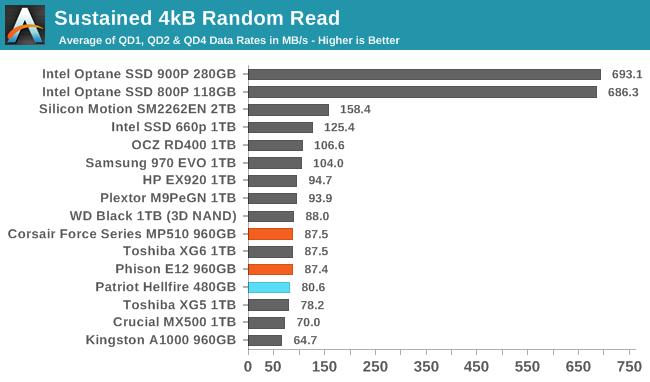
On the longer random read test that adds some higher queue depths, the MP510's performance standing falls somewhat as the Samsung 970 EVO and a few other drives with BiCS TLC overtake it, while Silicon Motion drives retain a commanding lead.
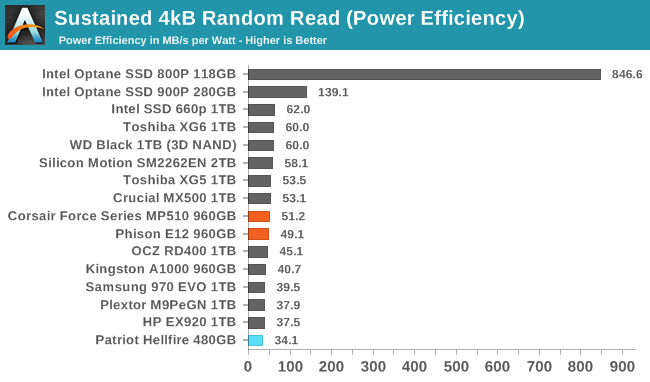 |
|||||||||
| Power Efficiency in MB/s/W | Average Power in W | ||||||||
The power efficiency of the MP510 during random reads is reasonable but is about 15% worse than what WD and Toshiba can do using their own controllers with this NAND.
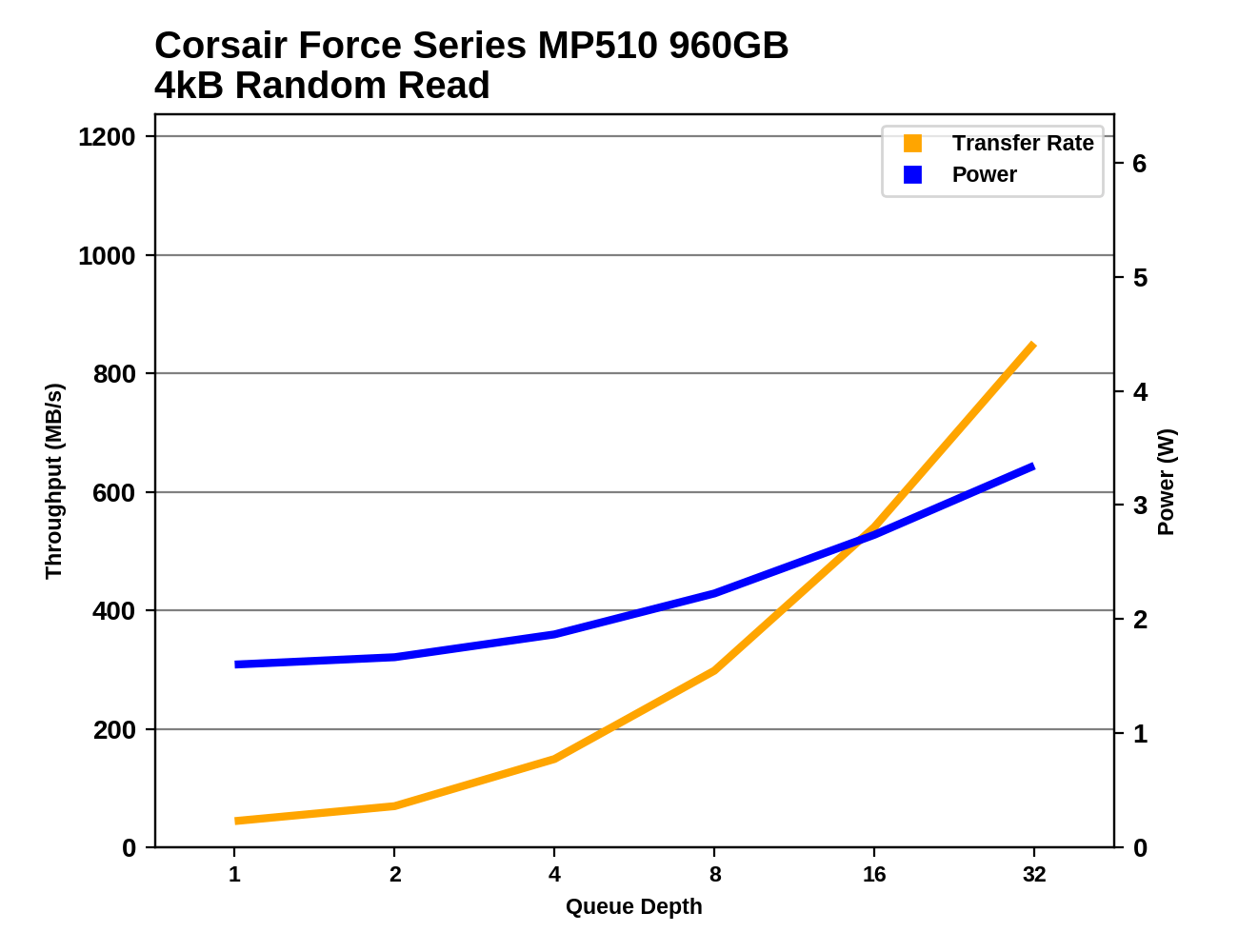 |
|||||||||
The MP510 may not provide the best random read performance at low queue depths, but its performance does scale up nicely when the queue depth continues to grow. By QD32 it is delivering over 800MB/s with a little more than 3W and showing no sign of approaching a performance ceiling; Phison's plans for enterprise drives based on this controller seem to have merit.
Random Write Performance
Our test of random write burst performance is structured similarly to the random read burst test, but each burst is only 4MB and the total test length is 128MB. The 4kB random write operations are distributed over a 16GB span of the drive, and the operations are issued one at a time with no queuing.

The Corsair Force MP510 is essentially tied for first place for burst random write performance: its SLC write cache has a very low latency.
As with the sustained random read test, our sustained 4kB random write test runs for up to one minute or 32GB per queue depth, covering a 64GB span of the drive and giving the drive up to 1 minute of idle time between queue depths to allow for write caches to be flushed and for the drive to cool down.
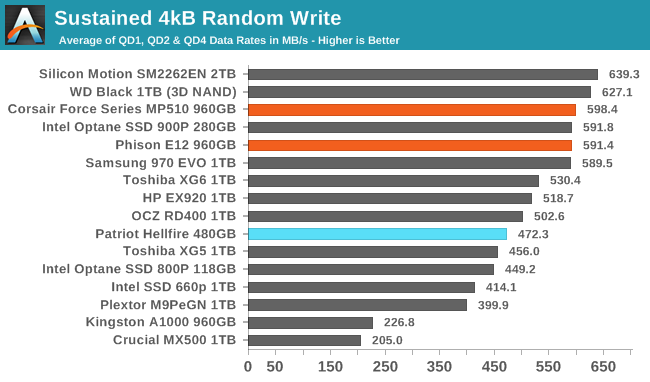
On the longer random write test, the Corsair MP510 loses the lead but stays in the top tier of high-performing drives.
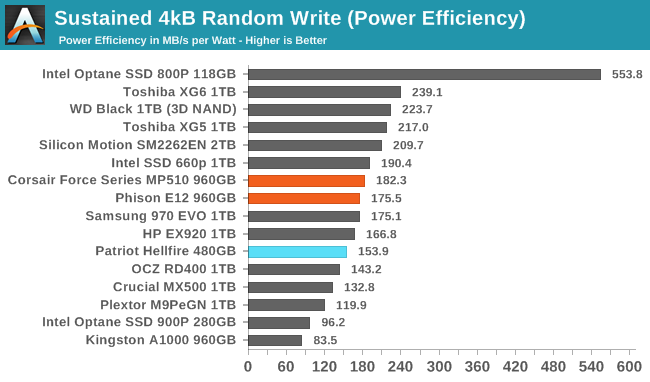 |
|||||||||
| Power Efficiency in MB/s/W | Average Power in W | ||||||||
The power efficiency of the Corsair Force MP510 during random writes is a bit better than average for NVMe drives, but significantly worse than what Toshiba and WD can do by pairing the same NAND with their own controllers. The WD Black manages this substantial efficiency advantage wil also slightly outperforming the MP510.
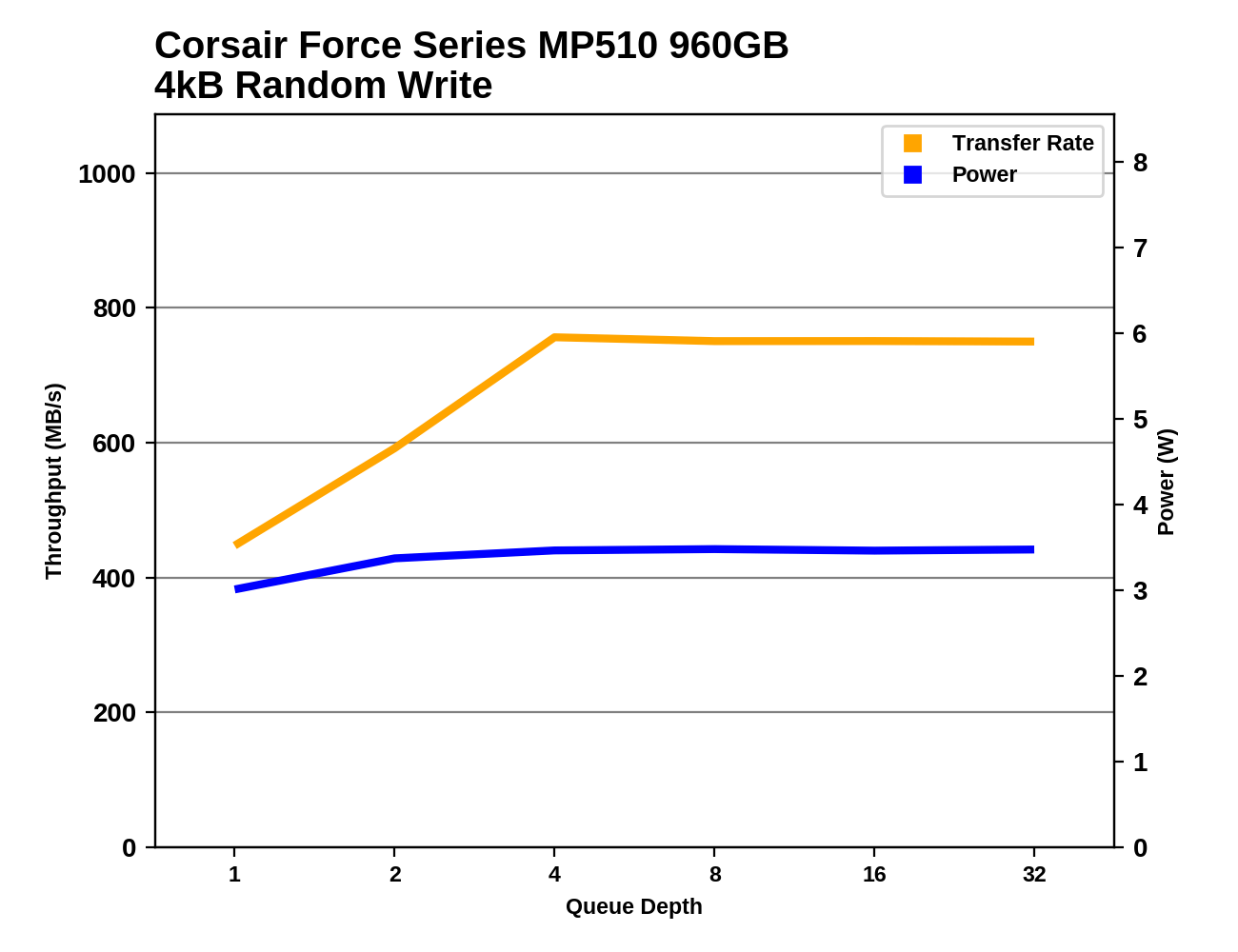 |
|||||||||
Like many of its closest competitors, the Corsair Force MP510's random write speed is saturated by QD4, but it plateaus well below the limit of the WD Black, which doesn't require any more power than the MP510.










42 Comments
View All Comments
imaheadcase - Thursday, October 18, 2018 - link
Wow, i had no idea how cheap SSD have come. You know, its getting to price points soon that home servers would easily use SSD drives vs mechanical.bill.rookard - Thursday, October 18, 2018 - link
If a 4TB drive becomes somewhat more affordable, then yes, they can. I guess it depends on how big of a server array you have. Personally, I have about 30TB in a 2U server using 4x4tb ZFS + 4x3tb ZFS for 20TB effective. Even a bargain basement setup for a similar size using the cheapest Micron 1100's 2TB SSDs you could find - you'd need 11 of them @ $280 each.Or - just a stitch over $3000.00. Meanwhile, the drives I used were factory refurbed enterprise drives and all 8 of them cost around $500.00
nathanddrews - Thursday, October 18, 2018 - link
I'm definitely waiting for larger SSDs to come down. I think if we ever get to $100/TB, I'll start to swap out more drives. 2TB for $199 would be great.I only recently started to experiment with "hybrid" storage on my home server. I've got about 40TB of rust with about 800GB of SSDs (older SSDs that didn't have a home anymore), using software to manage what folders/files are stored/backed up on which drives. UHD Blu-ray and other disc backups on the slow hard drives (still fast enough to saturate 1GbE) and documents/photos, etc. on the SSD array. My server doesn't have anything faster than SATA6Gbps, but the SSDs are still much quicker for smaller files/random access.
Lolimaster - Thursday, October 18, 2018 - link
I would upgrade to cheap 2.5-5Gbit NICnathanddrews - Thursday, October 18, 2018 - link
I've already got a couple 10GbE NICs, just waiting on an affordable switch...leexgx - Thursday, October 18, 2018 - link
use a PC :) youtube video of a person doing it do need to make sure you have the right mobo so it can handle 10gb speeds between PCI-E 10GB cards or you be getting low speeds between cards (still far cheaper than a actual 10gb switch)https://www.youtube.com/watch?v=p39mFz7ORco
Valantar - Friday, October 19, 2018 - link
You're recommending running a PC 24/7 as a switch to provide >GbE speeds from a NAS? Really?nathanddrews - Friday, October 19, 2018 - link
LOL that's a good joke! I mean, it's creative, but there's no way I'm doing that. I can wait a little longer to get a proper switch(es).rrinker - Thursday, October 18, 2018 - link
I'm at the point of contemplating a new server for home, and hybrid was the way I was going to go, since 16TB or so of all SSD is just too expensive still. But 1-2TB of SSD as fast cache for a bunch of 4TB spinny drives would be relatively inexpensive and offer most of the benefits. And SSD for the OS drive of course.DominionSeraph - Monday, October 22, 2018 - link
Yup, I picked up 24TB for $240. SSDs really can't compete.